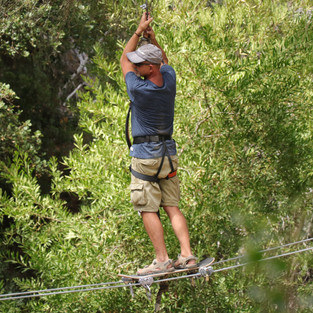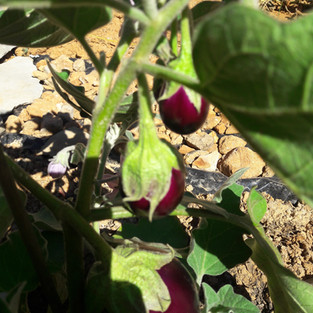Blog Dia 29: Irritations in irrigation iterations, and the summer harvest.
- Sylvie & jc
- Aug 24, 2020
- 4 min read
A couple blogs ago I swore my tile grouting days were over. Never say never they always say. A few months later, by the time we started spending our days outside, the weather went from good to great, from low 20's to mid 30's, and has stayed there ever since.

For a while we had no guests, and few bookings to look forward to. So we had the pool to ourselves. And there I noticed all the tiling around the pool, and the joints I had re-done the previous year...and now, the joints I had to re-do this year.
That's when I realized I will probably be doing some tile grouting every year for as long as we are here. Seismic activity is constant here, things move, imperceptibly, but still. Oh well...good thing I kept the knee pads. And it's just maintenance now. I'm OK with that.
So we moved on to our next challenge, the automatic irrigation system. The villa has automatic irrigation covering over 70% of the property (11'400 m2) with 8 main lines coming out of the pump room fed by source water from our borehole. Along each main line there are countless smaller lines connected with each having one of a variety of different sprinkler tips that deliver or spray water at different rates to dedicated plants, trees and lawns. The lines are sometimes above ground (exposed to sun), sometimes below, sometimes both.
Like a lot of things we discovered here, this is an excellent system, well planned and installed, but... things have been let go for a while and not everything is in proper working order anymore.
That's where we come in :-) And learn...
Of 8 lines, 2 have been decommissioned (or let to rot) so long ago there is no sense in trying to bring them back. The impacted trees are now old and big enough to thrive without irrigation it seems. The positive aspect is that it provides a lot of tubing and connectors and sprinkler spare parts for the 6 remaining lines. These are functional, so we decided we would control each and revamp every inch of the whole system.
Lesson 1: the borehole water is hard. All the sprinklers clog up.
Lesson 2: the sun cooks everything dry, all the lines have leaks
Lesson 3: fixing a leak moves dirt in the tubing that ends up clogging the sprinklers.
Lesson 4: fix leaks before cleaning sprinklers!
Lesson 5: there are about 2 km of main lines with a delivery line/ sprinkler about every 1 meter
Lesson 6: that's a lot of little sprinkler tips to clean!
Lesson 7: fixing a leak adds pressure to the line that will open up new leaks
Lesson 8: fix all leaks before cleaning sprinklers again!
Lesson 9: the proper garb for irrigation works is a bathing suit
Lesson 10: having 2 sons around to do the job is very handy
You might recall, we had created a vegetable garden during the springtime lock down. Things started growing quite well, but then the heat came on. This being a new feature on what was previously unused land it is not irrigated (yet). So we must water manually every day. So... we did not harvest much. A disappointment to say the least. We did plant some new trees (Orange, Lemon, Pomme grenade, Almond, etc) and those seem to be taking hold. So maybe next year if we start planting earlier in the garden maybe we get better results? We'll see.
This year we harvested alfarroba, pride and hope instead!

Alfarroba (Carob) trees are protected in these lands. They are everywhere. Every year we see the locals picking up the fruit, brown, hard, dried out, banana shaped beans about 10 cm long. These are turned into flour at local plants and the flour is used in cakes and food products, often as a substitute for chocolate or for it's stabilizing effects in recipes.
In previous years we gave them to whoever would pick them, or they got raked up and burned with the leaves. This year we read local stories about people harvesting bags full only to have them stolen during the night. So Sylvie decided to find out exactly how much this is worth. She, all by herself, set about to clean out every tree on the property (25 maybe 30!). Picking each bean off the ground and beating each tree with a long bamboo pole (as do the locals) to have ALL the remaining beans fall to the ground. She estimates about 24 hours of work over 2 weeks to harvest 333 kilos of carob. We delivered this to a plant about 4 km from here where our harvest was weighted and paid cash: 0.65 cents a kilo. I'll let you do the math. Does money grow on trees? Yes. Is it worth the effort? We'll see next year :-)
What did grow well this year are my 2 sons. They have grown into fine young men. They spent a month with us and worked every day we did. Some days they were the drivers that pushed us to do more than originally planned. Boy, or should I say Man, that's a refreshing. So beyond the joy of having them here, I got the pleasure of harvesting the pride of seeing them working hard, together,

doing a great job for Monte-Bougainvillea.
Speaking of which, bookings have been a surprise harvest. We really did not expect much for this year and prepared ourselves for the worst. Our main business driver is still down 90% year to date, but direct bookings from our own network and efforts have gone up many fold. All in all it looks like this will just be a bad year, no more, no less. That is much better than what we feared. For this we thank you, those of you reading this. With your bookings we have harvested hope.

It's a good thing I sorted out the tile grouting at the pool right away because we did not have it to

ourselves very long. We already know we won't for the rest of the season either. That's good news. It's too big not to share. And now the whole pool area has brand new LED lighting giving a nice ambiance at nighttime.
So we're still here, and we still have lots of projects. From here to our next blog we have a handful of new features and upgrades we are eager to announce. But we'll harvest those beans when they're ripe.
In the meantime,

hope to see you soon!
Sylvie & jc
Monte-Bougainvillea

























Comments